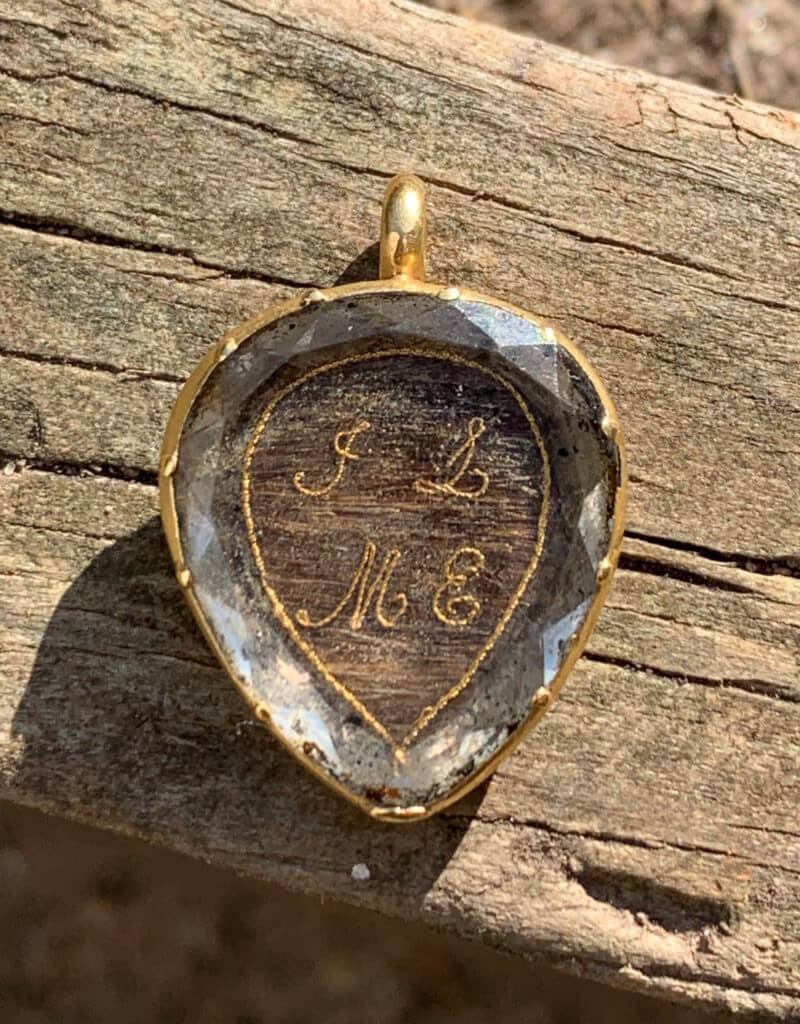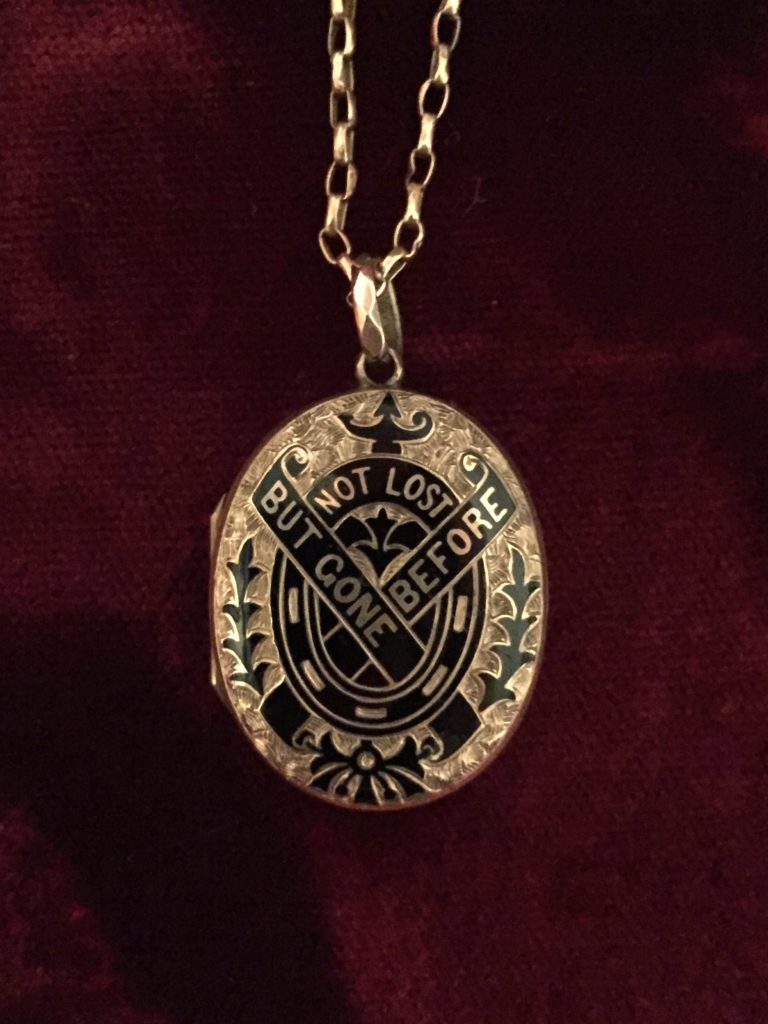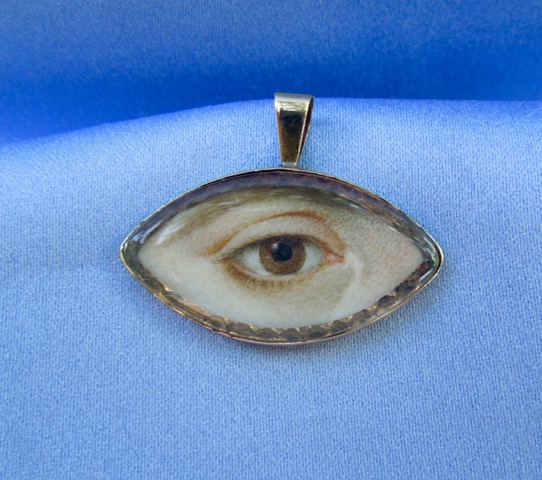Georgian Heart REGARD Locket
Every jewel is a remarkable monument to its time, its fashion, its very personality. Sentimental jewels are the embodiment of love between two people and identify the meaning (and potential future) of the person who had given them. A statement of love is one that resonates loudly throughout the ages, especially during times where sentimental jewels were worn predominantly, hence looking into the time, the construction and the reason for a jewel opens us up to a new world of understanding for jewellery and cultural history.
The Turn of the 19th Century
It cannot be understated how important the French influence upon sentimental jewels was in the turn of the 19th century. From the souvenir jewels stating such terms as “Souvenir d’amitié” and “Souvenir d’armour”, the statements of love that were worn on display created a new social proprietary that involved the use of sentimental jewels to offer admired people, within social circles, as signs of courtship and love.
Much of this sentiment stemmed from the French Revolution and its cultural challenge to established monarchy and religious value systems, particularly in the form of Liberté, égalité, fraternité (liberty, equality and fraternity). While the French Restoration of the first-quarter 19th century had repaired the monarchy itself, the challenge to established order had accomplished a lot to put new values in relationships and empower individuals. George IV encouraged society to look externally for artistic influence, since his ascendancy (and Regency, post Regency Act of 1811), George’s investment in the arts was required for the aristocracy to have these tokens of love as social requirements above simple affectations.
REGARD
The “Souvenir” jewels consistently reference “friendship” and this is a concept built from the nature of the relationship around piety and faith. As a concept itself, this is the very fundamental nature of a relationship, but in jewels, it can be seen written in posie rings from the 15th century onwards. ‘REGARD’, ‘DEAREST’ and ‘LOVE’ are the most English of the love token jewels from the 19th century to develop. This is due to the fascination and accessibility of precious stones, which allowed for the growing classes that had greater access to wealth the allowance to purchase jewels that would only have been accessible for the high aristocracy and Court.
REGARD: (R)uby, (E)merald, (G)arnet, (A)mythest, (R)uby, (D)iamond
LOVE: (L)apis-lazui, (O)pal, (V)ermeil (hessonite garnet) and (E)merald
DEAREST: (D)iamond, (E)merald, (A)methyst, (R)uby, (E)merald, (S)apphire, (T)opaz
Each of the first letter of the gems makes up the sentiment itself. This would normally be found in rings, brooches and pendants, often flanked with other love symbolism.
The cannetille (gold worked into filigree, inspired by embroidery) design motif is most prominently displayed on this locket, seen in the embellished designs to the very centre and the outer edge of the locket. Being a locket, this piece would have held a token of regard from the desired party to be given to the lady of affection, which we can only deduce to be hair. However, this heart locket is an interesting one, as it is larger in size than many of its contemporary pieces.
Heart
As written about extensively at Art of Mourning, the heart is one of the most important sentimental love symbols in early-modern history. Its obvious symbolism resonates today in tokens of love and affection, moving beyond religious and social values to be the most purely recognised understanding of love. With an anthropomorphic design, the heart symbol became popular in the 17th century with its romantic undertones of giving ‘your’ heart to another. For more on the development of this symbol, please consult “Embellished Georgian Heart Love Pendant” and the following articles:
> Georgian Heart with Hairwork Twist in Crystal, 1824
> Three-Dimensional Urn Locket, Garnets, Pearls and Ribbon!
> Georgian Eye Miniature Inside a Pendant, c.1820
> Late Georgian Heart Pendant With Hairwork
> Rien Sans Amitie, Cabochon Garnet French Mourning Locket
> Merit Claims Esteem/Bow Heart Locket, 18th Century
> French Ribbon Pendant, 18th Century
> 18th Century Ribbon Motif Pendant
> An Eternity Knot in a Crystal Heart Pendant
> Mourning Crystal “Georgian” Heart
> Stuart Crystal Heart Pendant with Angels and Crown
> Memento Mori Stuart Crystal Heart
> Diamond Navette Ring, Late 18th Century
> 18th Century Diamond Fede Ring
> Late Georgian Heart Pearl Pendant 19th Century
> The Hon Alice Nugent in a 1730 Mourning Locket and the Hairwork Eternity
> Is It, Or Isn’t It? Heart Pendant – First Impressions
Gems
The gems of the ‘REGARD’ jewels were often paste as well as being the real material, however, that doesn’t distract from their meaning and sentiment. The jewels are still being produced today, as the sentiment of a love jewel like this doesn’t ever become an anachronism until the language changes; as long as we use/spell the word ‘regard’ the same way today, these jewels will be mass produced.
Look for original ‘REGARD’ jewels to have their gems also changed. Wearing a jewel that does not leave the popular lexicon will never leave fashion, hence many of these jewels have been worn down and repaired. Many novice jewellers change the gem order, voiding the sentiment, however, a keen eye can spot the original jewel.
Ruby
The ruby belongs to the gem species corundum (a relation to the sapphire). Burma produces many of the finest rubies in the world, a bright red, also known as ‘pigeon’s blood’. Thai rubies are darker and known as ‘Siam rubies’. Otherwise, rubies can be found across the Indian sub-continent and Sri Lanka. Their magic properties include those of being able to increase the wearer’s divinity, protect from illness and force.
Emerald
Belonging to the gem species beryl (which contains aquamarine, golden beryl and morganite), emeralds are found on their own, rather than the others of the family which are mined. Fine stones are step-cut (also emerald cut), small stones are brilliant cut and lesser stones cut en cabochon. While widely mined in history (Egypt, Columbia, Brazil), the most popular are the Russian Ural Mountains since 1830, Australia from 1890 and South Africa from 1920. Known to fracture, emeralds should be scrutinised, as flawless (or ‘clean’) emeralds may be synthetic. Their magical properties are through to be ‘unlucky’.
Garnet
There are primarily four types of garnet used in jewellery, varying wildly in colour (red to green). The ‘almandine garnets’ are the deep red/violet garnet, popular in late 18th and early 19th century jewels. In the 19th century, cutting the almandine en cabochon would make it become a carbuncle.
Demantoid garnets were found in Russia’s Ural Mountains post 1850, hence their lack of use before this date in earlier jewels. Their colour is bright green, closer to that of an emerald. Hessonite garnets are bright orange in colour, with their main supply stemming from Sri Lanka.
It is the ‘pyrotype garnet’ that is better known as the Bohemian garnet, due to their source being southern Europe, are deep red and mostly popular in Victorian jewels.
Amethyst
Associated with the Church, due to the the intrinsic connection through the colour purple (robes), they are used in Bishop’s rings and crosses. The purple colour also allows for a third-stage mourning colour to be used in costume after the 1817 statement on Court Mourning by Lord Chamberlain. The religious connection here cannot be overstated, especially post 1840 and with the instillment of family values by Queen Victoria, following on from the Gothic Revival movement. A perfect amethyst should be deep purple and reflect colours of red when turned in the light.
Diamond
Diamonds are the most precious of the gems to be found in mourning and sentimental jewels; often denoting what level of society would have commissioned the jewel. Throughout the 17th to 19th centuries, only the finest of the jewels created housed the diamond, along with the four other precious stones of the ruby, emerald and sapphire.
A symbol of fearlessness and love, the origins of diamond mining were in India, c.500BCE. From the early 18th century, diamonds were found in Brazil, leading to the rise in production in Europe through to the 19th century. The most dramatic finding of diamonds next came rom Australia in the mid 19th century and South Africa at the turn of the 20th century. Only by this time did diamonds begin to reach lower classes, as the cost had dropped considerably, but that doesn’t mean a diamond shouldn’t be graded for its condition. ‘Finest white’ is the highest grade for a diamond, with the next being ‘fancy’ (‘coloured’), with its associated colour.
Paste
Paste has been in usage since ancient times to imitate gems, particularly diamonds. Essentially, paste is glass and faceted in a way to to reflect colour for a jewel to be visually attractive. For modern jewels, there were two reasons for paste to be instated in 17th century jewels (and onward). An English glass manufacturer named Ravenscroft discovered lead (flint-glass) that could be cut and polished producing extreme clarity. Parallel with this was the development of the brilliant-cut. In 1720, a Parisian jeweller named Strass combined the two processes in order to produce an emulation of exceptional quality. Other European jewellers did the same with tinted foils to produce remarkable facsimiles of proper gems. Between the 1730s and 1870s, good quality paste was produced, being overtaken by modern production techniques and lower quality products.
Acanthus
The acanthus is one of the most heavily used plants in decoration – if you’ve seen a Corinthian column, then you’ve more than likely seen the leaves as decoration. Own one of those fabulous Rococo Victorian Revival pieces of jewellery that I’m always harping on about with their ‘flourishes’? There you go.
So, from this, we know that it was a staple of Greek architecture and art, adopted by the Romans, carried through Byzantine architecture and revived for the Romanesque movement. You can find acanthus leaves decorating Medieval manuscripts and wood carvings, so there were quite few periods of art since that haven’t been touched by this magical plant at one stage or another.
When it comes to funerary art, the acanthus symbolises the heavenly garden. It is one of the oldest cemetery motifs, acanthus is associated with the rock ground where most ancient Greek cemeteries were placed.
But what about jewellery? Well, I’ve breezed through its importance in classical art, so it’s only natural that it would make an appearance during the Revival Periods, but it’s a form of embellishment that could be translated in gold to frame almost any style in between. The more stolid Gothic Revival of the early 19th century (look to around 1830-50) even had the acanthus used as a motif (though quite a lot smaller), and why not? It was used during the original Gothic period and one of the primary symbols of the Baroque period, so for as long as there has been a mourning industry, this design has made appearances. Though, whereas in the Neoclassical Period, you’ll see it used less in the gold work and more in the painted symbolism, it was still around. For the early 19th century Regency era, it was used less so, as cleaner, straight lines ruled the day, but when there was cross-pollination with the Rococo period of the 1740s (styles were never killed off completely), then you’ll find it used as an embellishment here and there. By the mid-19th century Rococo Revival, then it made its full bloom once again.
Grape
The grape can also represent Dionysus, but we’ll look to the more familiar variations for this symbol. It is not uncommon to find the leaf used in Christian churches or funeral funeralia, as they also show the triumph of victory over death and the joys of heaven.
In literal terms, look at the symbol itself and note the behaviour of the grape. It is a plant which grows in abundance and one of the earliest cultivated crops known to mobilised society, hence the connection to the symbol bearing fruit for the harvest. Here is an element of birth/rebirth within the representation of the grapes and also its connection to victory, as the ripe harvest shows the promise of the fruits rewards being reaped and turned into the production of sustenance for the future as well as a product which promotes happiness. In this, there is the link towards Dionysus, with the vine being worn by cult members to represent a god closely connected to wine (also the bull, serpent and ivy) and its intoxicating effects. Interestingly enough, there are parallels between Dionysus and Jesus that stem from the transubstantiation of water/wine and resurrection, but I find that these reinforce the symbol’s intent and its use when worn in jewellery.
The motif can be found in Neoclassical pieces, but much more commonly in the second half 19th century pieces, where it is often embellished in lockets, pendants or manufactured as charms. When used in Neoclassical depictions, the symbol is often a secondary motif, relegated to being a symbol that works in conjunction with its surroundings to enhance symbolic meaning, such as wrapped around a column or plinth, combined with oak, held by the human subject of the depiction or bordering the piece itself. In the 19th century uses, post 1840 and the re-introduction of Christian family values (which we’re going to discuss in the new year quite in-depth), the symbol becomes one used prominently and often alone – note the use in the pieces above. These two pieces are using different materials, but both show the symbol as the central focus to the piece itself. Much of this usage is directly because of its Christian leaning as a symbol and for the very reason that the symbol conveys a positive message of rebirth/birth.
Ivy
If the fundamental conceptual symbolism was lost in that little introduction, evergreen represents life and eternity (essentially immortality), along with clinging attachment. During the 19th century, it would not be uncommon to give a gift of ivy in order to express fidelity, friendship and eternity. For the ancient Greeks, ivy was used to crown victorious athletes and for the Romans, intellectual achievement.
From these concepts, ivy is one of the plant symbols that expresses itself well from its natural format to its interpretations. All one needs to do is describe the plant and the meaning reveals what it is conceptually. Due to its classical heritage, ivy is a symbol that lasted throughout the medieval period into the modern, being an embellishment on illuminated manuscripts, used in many of the Baroque and Rococo designs from the 16th-18th centuries and would constantly be used in Victorian art.
Due to this, it survived as an embellishment in rings, pendants, slides and bracelet clasps, particularly from the post 1680 period, being reinterpreted from around 1760 in Neoclassical depictions (painted on ivory, vellum as a secondary motif), then through the 19th century as etched in gold and silver or painted in enamel. Its versatility, as mentioned previously, is its lack of reliance on direct religious context and more upon its natural/classical meaning, making it a beautiful decoration and one with an essential meaning.
Relationships
Regarding this jewel as a locket that held the love for another in a literal and symbolic way, this heart-shaped locket was a delivery message of affection that still resonates strongly today. Its creation, be it designed by a jeweller and purchased for a token of love, or commissioned specifically by a person does not change its sentiment. When considered with the ‘DEAREST’ and ‘LOVE’ sentiments that were also common of the time, this isn’t a statement that cements a relationship. ‘REGARD’ is a sentiment that makes indications of affection and the prospect of love and a relationship stemming from that, yet when a jewel is as grand as this locket, the likelihood of a future in the relationship is a strong one.
Further Reading:
> REGARD This Necklace As Perfect










